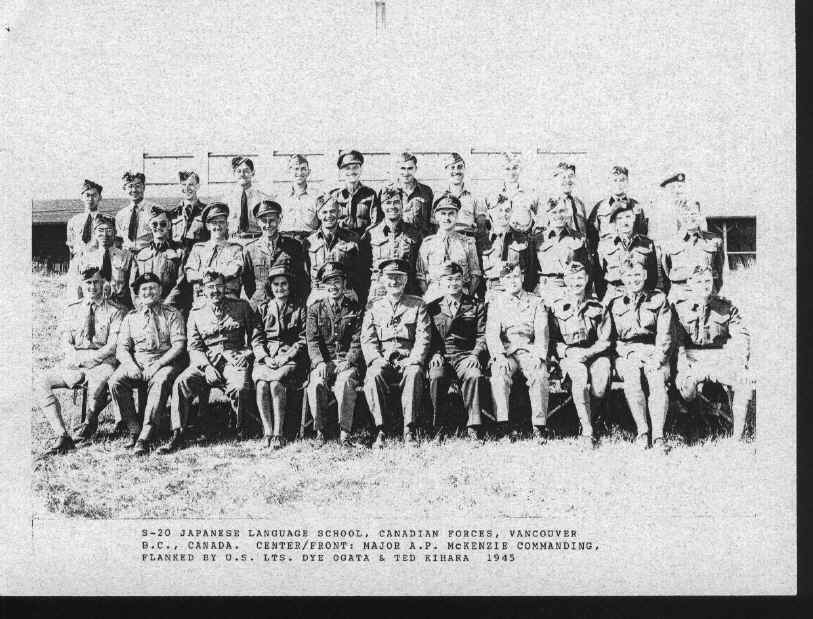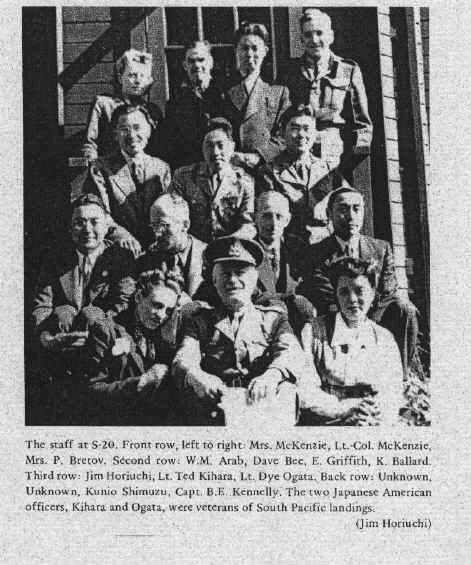
ASSIGNMENT CANADA by Dye Ogata
Two years from graduating as the First Class Savage, MN, destiny would have it that I would return to MISLS (Military Intelligence Language School). For 18 months we had spent overseas hopping islands along the Solomon Group. Thanks to my Lucky Star, this time my career brought me back from overseas to attend OCS (Officer Candidate School) and now I was a Shavetail reporting to duty at Fort Snelling, MN. The date is December 16, 1944.
Assignment to Fort Snelling was directed by some unseen directive that guided many Niseis to MISLS. Not all were happy with this military arrangement and would have preferred service as a real blood-and-guts infantryman. I was not alone but one of several who had completed the course for a Platoon Leader at Fort Benning, GA.
Within days of my arrival, the staff (John Aiso, Paul Rusch, and others) decided that I should give a pep talk of a sorts before the entire student body. Sadly, this put me on the ‘hot seat’ as any inclination on my part to embellish the rigors of military campaigns had been long forgotten as I had left Bougainville one year earlier in December 1943. Mind you, there were no props, slides, movies and the like to illustrate life in the field. I would have liked to expound on the incessant bombings we had endured and more especially the bombing that buried me alive. This would not have been a pep talk but it would have been a real authentic war story minus the ear-deafening boom.

As a member of his staff, John Aiso designated me as School Property Officer, Fire Marshall and Instructor of American Military Terms. This was a purely administrative assignment that set me off in several directions with a small staff Instructions, directions, layout of classrooms, alt of these tasks required composing and printing of materials using the Ditto Machine and Mimeograph. After a couple months, the assignment seemed within my grip of things and just as I began to feel settled at the job, John Aiso announced he had an overseas assignment for me and Lt. Ted Kihara.
This was a shocker as Ted and I had both spent 18 months overseas in the Pacific. Surprise, surprise, this was not an ordinary assignment but a ‘per diem’ tour covering only a few months. This assignment meant we would receive a cost of living allowance separate from our pay. This assignment was to Canada where we would be attached to Canadian Military Forces, specifically to a Japanese Language School being formed in the city of Vancouver, British Columbia.
For an assignment such as this, one assumes that the request for assistance originated in Canada and was transmitted through diplomatic channels to the War Department, to (G-2 and ultimately to MISLS. As foot soldier, what were we suppose to know? Just Get Your Orders And Get Going!
We flew on Delta Air Lines whose route would take us through my home town. At a short stopover at Helena, MT I had a short visit with my parents en route to Vancouver. Upon arrival on Apr. 13, 1945 at Vancouver, we reported to the US. Liaison Office there and then proceeded to S-20, the Japanese Language School commanded by Major A.P. McKenzie. Our military quarters, or billets as they called them, was at Jericho Beach Billets. Each billet had a Batman , the orderly who attended to our needs. The facilities were not too shabby and the beer had a pretty good bang. We had come with our usual barrack bags and case. We brought no training materials, such as dictionaries, readers or references of any kind.
At this point, Canada had begun preparing for war in the Pacific after having spent several years helping the Commonwealth wage war against Germany. As veterans of the Pacific War we were suppose to know it all, whatever that meant. Actually, we had seen very little of the Japanese enemy; he flew over us on moonlit nights and kept us awake up and down the Solomon Islands. You could not take the enemy alive unless he was badly wounded or he came down crashing into the ground in which case there were only small pieces of their flying machine or them, as was the case when we joined crash investigations.
Major McKenzie, our Commandant was fluent in Japanese having been born in Japan and having lived there until he was nineteen. The U.S. Navy had once invited him to teach Japanese at Harvard. His credentials are welt treated in a 1984 publication authored by an S-20 graduate named Roy Ito whose book is entitled "We Went To War" (The Story of The Japanese Canadians Who Served During The First And Second World War).
The first time I had seen Vancouver was through a porthole in 1938 while en route to Japan aboard one of those ocean liners. I sailed from Seattle and my first stop was at Vancouver where the ship loaded logs. Logs seemed peculiar as cargo but these were of a certain kind of tree used in Japan for making matches. The second time was in April 1945 when Ted and I were assigned to S-20, the Military Intelligence Division, Canadian Army. And the third time was in 1970 when I came as a Landed Immigrant to live and work for 15 years after having been retired by Central Intelligence.
Recalling the events of 50 plus years ago, I remember the wartime situation on consumer goods. There was rationing at home and things like bacon, bed sheets and silverware were not readily available. In Canada it was quite a different situation in that all of these were available. One peculiar aspect of home-making was the cooking stove. Lumber, a major industry, had as its byproduct, sawdust. This was used as fuel for the cooking stove and the results were not too satisfactory because of the low heat output and the unavoidable smoke.

Across Canada each province had its own laws on citizenship and whether one ethnic group could enlist or not, especially in British Columbia. East of the Rockies, Nisei could enlist and this is where they went to enlist. On the War Front, the British moved ahead of the Canadians in recruiting linguists and Nisei enlisted early before their own country made any overtures.
History will show there were paralleling events between the government there and here. When WW II began, liberal governments ruled in both countries, one led by W. Mackenzie King there and one led by F.D. Roosevelt here. The uprooting of anyone with Japanese blood regardless of citizenship was applied in both countries. In B.C. there were Japanese who became naturalized as British citizens, yet they could not vote there because of disenfranchisement. The losses suffered from confiscation and evacuation were much greater per capita for those in B.C. Canada. This because assets of the Japanese Canadians were sold and revenue used to defray the costs of their own internment.
In B.C. all persons of Japanese descent were removed 100 miles inland starting on Feb.
24, 1942; here it was Feb.19, 1942 (EO 9066). They were not allowed to return to B.C. until 1949; here it was 1945 when evacuees were allowed to return. Public security was the mandate of the RCMP (Royal Canadian Mounted Police) there and here it was the FBI (Federal Bureau of Investigation)Since Ted and I were in U.S. Army uniform and carrying orders, we were allowed entry without any trouble. It was considered a Protected Area and for the Japanese Canadian Staff of S-20 as well as its students, a special dispensation was granted. However, there was an odd twist in the way the prohibition was applied. Ted was not married but I was and when permission was sought to have my wife join me white on duty there, the request was summarily denied. Several pieces of correspondence on this matter of extraterritorial rights that B.C. practiced even on Japanese Americans, is attached as enclosures.
Not in the record is the manner by which an overruling of this B.C. doctrine, was successfully won. It required a special mission to Ottawa by none other than the Commandant of MISLS, Col. K. Rasmussen. Only then was my wife able to join me.
During our stay in Vancouver we encountered isolated instances of prejudice even though we were wearing an officers’ uniform of the United States Army. In the Canadian Military we felt completely welcome whether they were Anglophones or Francophones. History records in 1914 a ship chartered by East Indians, was denied entry in B.C. and kept offshore until it sailed away. This was known as the "Komagata Maru Incident" that sparked a race riot killing 20 people.
Our duty at S-10 covered four months and ended while the war itself was entering its final days. The day before Japan surrendered, we departed Vancouver to return to MISLS. However, with the advent of surrender, our orders were changed assigning us to PACMIRS (Pacific Military Research Section) at Camp Ritchie, MD. Several S-20 graduates had been assigned here during 1945; these were followed by many more during 1946 by which time S-20 had closed its doors and became history.
At the conclusion of this Diaspora of a sorts, at long last there was a realization that wartime exigencies did not really require mass exiling of people within their own country but rather it was a matter of greed and not need. It was people who were enfranchised seeking to enrich themselves at the expense of the disenfranchised in large measure. Race was used as a ‘Joker’ in a game of political poker.
Federal governments issued Apologies and Redress was granted to the Issei and Nisei. The White House Letters of Apology, on textual comparison show President Bush mentioned Japanese Americans once and President Clinton mentioned them twice. The Canadian Prime Minister issued the most elaborate text in which Japanese Canadians were mentioned five times, and it mentioned the fact that their treatment violated the Principles of Human Rights.